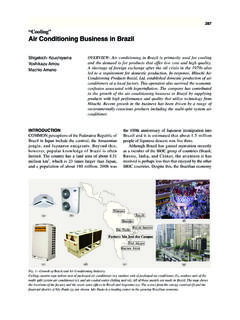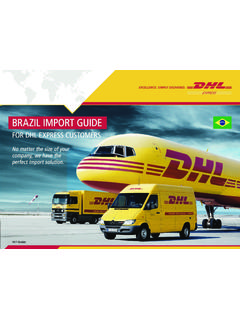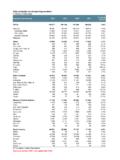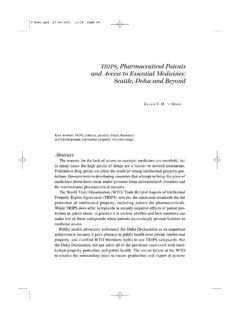Transcription of Brazil: Bolsa Familia Program – Scaling-up Cash …
1 brazil : Bolsa Familia Program Scaling-up Cash Transfers for the Poor 67 MfDR Principles in Action: Sourcebook on Emerging Good Practices brazil : Bolsa Familia Program Scaling-up Cash Transfers for the Poor Author: Kathy Lindert, Senior Economist, LCSHS - World Bank Executive Summary In 2003, the government of Luiz Ignacio Lula da Silva launched a comprehensive Program to stimulate growth and social progress. On the social side, the centerpiece was a sweeping reform of brazil s social safety net, the Bolsa Fa-milia Program (BFP), which integrated four cash transfer programs into a single Program under the umbrella of a new Ministry of Social Development. The transfers are made preferentially to women in each family. The Program sup-ports the formation of human capital at the family level by conditioning transfers on behaviors such as children s school attendance, use of health cards, and other social services. Since its launch, the Bolsa Familia Program has grown exponentially, and by January 2005 had expanded to cover about million people.
2 By the end of 2006, about 44 million people are expected to be covered, at least two-thirds of whom are extremely poor. In terms of numbers of beneficiaries, the Bolsa Familia Program is by far the largest conditional cash transfer in the developing world. Its systems for beneficiary selection, monitoring and evaluation, quality control, and scaling up have implications that extend well beyond brazil . The World Bank s project to support the Bolsa Familia Program was conceptualized within a results-based manage-ment framework, of which there are two key aspects. First, mechanisms were developed to pace loan disbursements according to results for example, through concrete technical improvements in areas such as beneficiary targeting. Activities undertaken under three technical components of the loan cumulatively contribute toward attainment of per-formance milestones. As these milestones are demonstrably met, they trigger increases in the rates of loan disburse-ments. Disbursement percentages increase from 8 to 9 to 11 percent, depending on performance.
3 Second, the project includes a monitoring and evaluation system that is focused on results and thus intrinsic to both the architecture and the implementation of the Program . The Need to Extend and Strengthen brazil s Social Safety Net in a Hurry In 2003, the newly elected government of Luiz Igna-cio Lula da Silva launched a comprehensive Program to stimulate rapid growth and social progress. On the social side, the centerpiece of this effort was known as Bolsa Familia , a sweeping reform of brazil s social safety programs that consolidated four federal cash transfer programs (see box) and coordinated them with other social programs and policies. What are Conditional Cash Transfers? Conditional cash transfers provide money directly to poor families via a social contract with the beneficiaries for example, sending children to school regularly or bringing them to health centers. For extremely poor families, cash provides emergency assistance, while the conditionalities promote longer-term investments in human capital.
4 As of January 2005, Bolsa Familia covered mil-lion families and accounted for about a quarter of brazil s social safety net spending. By the end of 2006, the consolidated Bolsa Familia proposes to cover million families (about 44 million people). The social investment would represent an increase from percent to percent of total government expenditure, and an increase from percent to percent of brazil s GDP. The Bolsa Familia Program was prioritized by the Lula administration as its flag-ship social Program . Why existing programs needed to be reformed. Four pre-reform safety net programs were included in the Lula administration s safety net consolidation: Bolsa Escola (Ministry of Education), Bolsa Alimenta o (Ministry of Health), Cart o Alimenta o ( Fome Zero), and Aux lio Gas (Ministry of Mines/Energy). Although each of these programs had its own empha-sis promoting schooling, health care, food consump-tion, compensation for fewer government subsidies, and so forth the separate programs were redundant and difficult to administer.
5 They all provided cash transfers to roughly the same target population. Each had its own separate administrative structure, data collection, fiduciary procedures, and public reporting. The resulting safety net was filled with both gaps and redundancies in coverage, and the programmatic fragmentation sacrificed opportunities for synergies at 68 Part 3. Examples of MfDR in Sector Programs and Projects MfDR Principles in Action: Sourcebook on Emerging Good Practices the family level among schooling, health, nutrition, and other services. What integration accomplished. The Bolsa Familia Program integrated the four programs into a single conditional cash transfer Program under the umbrella of a new Ministry of Social Development. Integration of the four programs made better use of public re-sources by reducing administrative costs and improv-ing the system for targeting the beneficiary popula-tion. The Program and methodology were extended vertically to integrate the federal Program with the state and municipal safety net programs, further ex-tending and consolidating (or coordinating) the overall safety net.
6 By standardizing results indicators and administrative procedures under a single Program (rather than four separate programs), bureaucratic complexity was reduced. Finally, integration of the Program as a concept that is, as a way of thinking about, discussing, and planning, as well as administer-ing encouraged natural synergy opportunities for larger-scale actions related to education, health, and nutrition for the poor. Objectives The Bolsa Familia Program has two main objectives. The first is to reduce brazil s current poverty and ine-quality by means of direct monetary transfers to poor families. The second objective is to reduce future pov-erty and inequality through incentives for poor fami-lies to build their own human capital, that is, positive incentives to keep children in school, send them to health centers, and seek other complementary social services. Doing so requires two kinds of conditions: Quantitative a far greater number of (properly targeted) poor people brought into the safety net Qualitative significantly better outcomes, as assessed by demonstrable improvements in clear, understandable indicators of well-being for each beneficiary, as well as improvements in the trans-parency of processes used in implementation More broadly, brazil s commitment to the Bolsa Fa-milia objectives also served to better align the country with the Millennium Development Goals for exam-ple, reducing malnutrition (MDG 1), achieving uni-versal education (MDG 2), reducing child mortality (MDG 4), and improving maternal health (MDG 5) through the demand-side incentives for investments in education, nutrition, and health for pregnant women and young children.
7 Design and Implementation Building on a foundation of previous programs and lessons learned, the Bolsa Familia Program was de-signed around four key management concepts: The family unit (rather than the individual or a community) was the appropriate entity to receive the benefit and should in turn bear responsibility for meeting the Program s requirements. Conditionalities to link transfers to positive incen-tives for human capital investments were viewed as fundamental to strengthening the investment role of the Program for long-term poverty reduc-tion. Through attention to vertical integration, comple-mentary decentralized partnerships could be de-veloped through state and municipal social pro-grams. A Unified Household Registry (referred to as the Cadastro nico) is being strengthened through technical improvements to better serve as a mechanism for targeting beneficiaries as well as for administration and overarching policy plan-ning.
8 Targeting the poor. By design, Bolsa Familia identi-fied two target groups the extreme poor (families with a per capita income of less than US$17 per month) and the moderately poor (families with a per capita monthly income between US$17 and $34). De-pending on the household s composition and income, the Program provides cash transfers ranging from US$5 to $33 (the average is US$24). These amounts were set, in part, to minimize the number of people who might lose benefits from previous programs. On a per capita basis, the average transfer per beneficiary represents about 6 percent of the minimum wage and 19 percent of the poverty line used by the World Bank. Conditionalities aimed at human capital formation. By law, payments are made preferentially to the mother of the household because a substantial body of research has demonstrated that women are more likely to prioritize investments in children s education, health, and nutrition.
9 The cash transfers are condi-tional upon all relevant members of the family com-plying with the clearly defined human development requirements of school attendance, prenatal visits, vaccinations, and use of other social services. Innovative features of the lending instrument. The World Bank s loan to support the Bolsa Familia pro-gram is a tailor-made package that combines three innovative design features. First, a two-phase Adapt-able Program Loan (APL) was devised. The first phase (2004-06) focuses on strengthening the effec- brazil : Bolsa Familia Program Scaling-up Cash Transfers for the Poor 69 MfDR Principles in Action: Sourcebook on Emerging Good Practices tiveness of the safety net by consolidating the four conditional cash transfer programs, reducing gaps and duplication in coverage, improving systems for identi-fying the target population, and developing an effec-tive monitoring and evaluation system. The attainment of key objectives measured by clearly defined re-sults indicators serves as a series of triggers to move implementation to the APL s second phase (2007-08), which is designed in turn to consolidate and deepen the technical improvements and innovations of the first phase.
10 International Donor Support The Brazilian government requested the World Bank to partner the BFP in the context of longstanding Bank sup-port for its social agenda under the Policy Sector Reform framework. These efforts included a three-year rolling Program of economic and sector work on social assis-tance, supported by the Bank and the In addition, UNDP supports Bolsa Familia through the Ministry of Social Development, and the Inter-American Develop-ment Bank has undertaken a parallel initiative for a SWAp project to support the Program . The Bank s four-year pro-ject loan, excluding counterpart funds, is expected to be US$ million. Second, the project was developed with a SWAp component (see box) of US$551 million that serves primarily to reimburse the government for conditional cash transfer expenditures. In addition, a separate technical component was designed to improve benefi-ciary targeting (US$ million). A technical component was designed to develop the new monitoring and evaluation system, including de-velopment of instruments and processes to track eligi-bility, payments, conditionality performance, etc.








